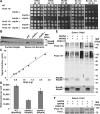Functional roles of the DNA-binding HMGB domain in the histone chaperone FACT in nucleosome reorganization
- PMID: 29514976
- PMCID: PMC5912460
- DOI: 10.1074/jbc.RA117.000199
Functional roles of the DNA-binding HMGB domain in the histone chaperone FACT in nucleosome reorganization
Abstract
The essential histone chaperone FACT (
Keywords: DNA-binding protein; FACT; HMGB domain; chromatin dynamics; chromatin regulation; chromatin structure; histone chaperone; nucleosome; nucleosome reorganization.
© 2018 by The American Society for Biochemistry and Molecular Biology, Inc.
Conflict of interest statement
The authors declare that they have no conflicts of interest with the contents of this article
Figures








Similar articles
-
Insight into the mechanism of nucleosome reorganization from histone mutants that suppress defects in the FACT histone chaperone.Genetics. 2011 Aug;188(4):835-46. doi: 10.1534/genetics.111.128769. Epub 2011 May 30. Genetics. 2011. PMID: 21625001 Free PMC article.
-
The Abundant Histone Chaperones Spt6 and FACT Collaborate to Assemble, Inspect, and Maintain Chromatin Structure in Saccharomyces cerevisiae.Genetics. 2015 Nov;201(3):1031-45. doi: 10.1534/genetics.115.180794. Epub 2015 Sep 28. Genetics. 2015. PMID: 26416482 Free PMC article.
-
FACT Disrupts Nucleosome Structure by Binding H2A-H2B with Conserved Peptide Motifs.Mol Cell. 2015 Oct 15;60(2):294-306. doi: 10.1016/j.molcel.2015.09.008. Epub 2015 Oct 8. Mol Cell. 2015. PMID: 26455391 Free PMC article.
-
Histone chaperone FACT FAcilitates Chromatin Transcription: mechanistic and structural insights.Curr Opin Struct Biol. 2020 Dec;65:26-32. doi: 10.1016/j.sbi.2020.05.019. Epub 2020 Jun 20. Curr Opin Struct Biol. 2020. PMID: 32574979 Review.
-
Regulation of chromatin structure and function: insights into the histone chaperone FACT.Cell Cycle. 2021 Mar-Mar;20(5-6):465-479. doi: 10.1080/15384101.2021.1881726. Epub 2021 Feb 16. Cell Cycle. 2021. PMID: 33590780 Free PMC article. Review.
Cited by
-
Structure-function relationship of H2A-H2B specific plant histone chaperones.Cell Stress Chaperones. 2020 Jan;25(1):1-17. doi: 10.1007/s12192-019-01050-7. Epub 2019 Nov 9. Cell Stress Chaperones. 2020. PMID: 31707537 Free PMC article. Review.
-
The histone chaperoning pathway: from ribosome to nucleosome.Essays Biochem. 2019 Apr 23;63(1):29-43. doi: 10.1042/EBC20180055. Print 2019 Apr 23. Essays Biochem. 2019. PMID: 31015382 Free PMC article. Review.
-
The human RNA polymerase I structure reveals an HMG-like docking domain specific to metazoans.Life Sci Alliance. 2022 Sep 1;5(11):e202201568. doi: 10.26508/lsa.202201568. Print 2022 Nov. Life Sci Alliance. 2022. PMID: 36271492 Free PMC article.
-
Partial Replacement of Nucleosomal DNA with Human FACT Induces Dynamic Exposure and Acetylation of Histone H3 N-Terminal Tails.iScience. 2020 Oct 6;23(10):101641. doi: 10.1016/j.isci.2020.101641. eCollection 2020 Oct 23. iScience. 2020. PMID: 33103079 Free PMC article.
-
Histone Chaperone FACT and Curaxins: Effects on Genome Structure and Function.J Cancer Metastasis Treat. 2019;5:78. doi: 10.20517/2394-4722.2019.31. Epub 2019 Nov 29. J Cancer Metastasis Treat. 2019. PMID: 31853507 Free PMC article.
References
Publication types
MeSH terms
Substances
Associated data
- Actions
- Actions
- Actions
- Actions
- Actions
- Actions
- Actions
- Actions
Grants and funding
LinkOut - more resources
Full Text Sources
Other Literature Sources
Molecular Biology Databases

